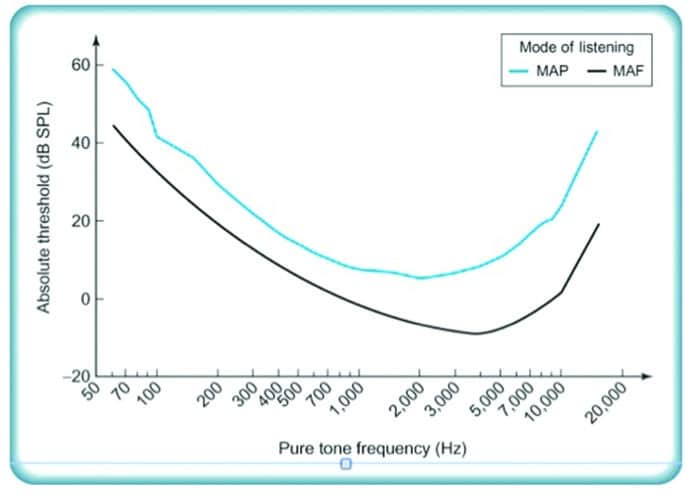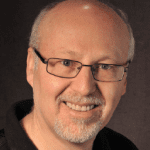Back to Basics | August 2016 Hearing Review
I sometimes wonder whether our ability to hear at 1000 Hz is 7 dB SPL, 3 dB SPL, or 0 dB SPL? While this doesn’t necessarily keep me up at night, it does bring up some issues that have direct clinical relevance. The Minimal Audible Field (MAF), or the softest sound that normal-hearing people can hear in the normal diffuse sound field at 1000 Hz, is near 0 dB SPL if we use a broad band stimulus such as white noise or speech.

Figure 1. Equal loudness contours depend on whether sound is measured under earphones (MAP) or in the sound field (MAF). In this case the MAF used puretone stimuli, as evidenced by the 3 dB SPL value at 1000 Hz. This relates to the crest factor of a puretone being 3 dB. The peak is at 3 dB and the RMS was at 0 dB SPL. Figure courtesy of www.cffet.net.
However, if we look at MAF curves, there is typically a dotted line at 3 dB SPL and not 0 dB SPL. This is directly related to the crest factor of the signal used to obtain the MAF curve-filtered broad band noise, or that of a pure tone. Pure tones have a crest factor of 3 dB—the difference between the peak and the average (or RMS of the signal). Since this is a test of detectability, the peak (at +3 dB) is the stimulus, whereas the RMS or “SPL value” of the pure-tone is 3 dB lower. This explains the difference between the 3 dB result at 1000 Hz and the RMS value which would be at 0 dB SPL.
Pure tones are used everywhere in hearing assessment, from audiometry to evoked response stimuli. And while it’s easy to control, there is very little reality for using a pure tone. This of course is an inherent limitation for generalizing the usefulness of the pure-tone audiogram (see the March 2016 HearingReview.com article, “Rants”).

Figure 2. This is a comparison between the minimal audible thresholds when using occluding earphones (MAP) and when listening in the sound field (MAF). The lower frequency difference is related to the masking spectrum of vascular noise and the higher frequency difference is related to the different resonant characteristics of the outer ear. Figure courtesy of www.Studyblue.com.
We listen to music and speech in two ways: under earphones and in the sound-field (unamplified or amplified through loudspeakers). Listening in the sound-field (MAF curves)—the way we listen to people and to live music—gives slightly better acuity in the mid- and low-frequency region than listening under earphones (Minimum Audible Pressure or MAP). When our ears are occluded with an earphone, vascular noise of the blood coursing through our arteries becomes audible, masking some of the lower frequency sounds. In fact, if one were to subtract the MAF 0 phon curve from the MAP 0 phon curve, the resulting spectrum would be that of the vascular noise, at least below 1500 Hz. Above 1500 Hz, the unoccluded resonant characteristics of the ear canal come into play—we are dealing with a half wavelength resonator versus the quarter wavelength resonator with an unoccluded earcanal.
I prefer listening to recorded music and speech through loudspeakers rather than earphones. This provides me with a bit more bass sound, especially for the quieter elements of music, than is discernible through earphones. This is also the reason I use loudspeakers instead of earphones when listening to and transcribing phonetic details in my linguistic research—I am equal parts musician, audiologist, and linguist.
Yet, being able to hear the lower frequency sounds of speech or music should not be over-emphasized. We don’t need to hear the note with a tonic at 65 Hz (two octaves below middle C) in order to “hear” it, for example. Our auditory systems are quite amazing and it turns out that all we need to hear is the difference between two adjacent harmonics. This is true regardless of whether the 65 Hz difference is between 65 Hz and 130 Hz or between 1000 Hz and 1065 Hz. It’s the difference that matters, and this is the basis behind the psychoacoustic concept of the “missing fundamental.” Extending the lower frequency region to the extreme lefthand side of the piano keyboard in a hearing aid fitting is misguided. A bit is good…a lot is bad.
Marshall Chasin, AuD, is an audiologist and the Director of Auditory Research at the Musicians’ Clinics of Canada, Adjunct Professor at the University of Toronto (in Linguistics), and Associate Professor in the School of Communication Disorders and Sciences at the Western University. He is the author of over 200 articles and 7 books including Musicians and the Prevention of Hearing Loss. He has also recently developed a new app called the Temporary Hearing Loss Test app.
Correspondence can be addressed to: [email protected]
Original citation for this article: Chasin M. Back to Basics: Hearing: Is it 7 dB, 3 dB or 0 dB? Hearing Review. 2016;23(8):12.?






Back to the basics? I love that.
Whenever we hear any form of sound, including speech sounds, our immediate reaction is identification and understanding of that, and this processing generates cognitive responses of attention and identification. Attention will increase the apparent input by a efferent response that will “amplify the input for easier processing, while identification will be facilitated by spatial action at the pyramidal level of neurons in the hippocampus (CA3)There is a back and forth mediation between LTP neurons and short term memory stabilization that is always transient.Once this process is complete, we hear, listen and understand! The concept of threshold is now derelict, and cognitive mechanisms need to be addressed. Hence this state of fluidity needs objective analysis.
Jay Muhury.